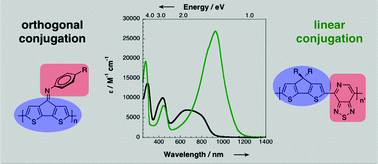Structural dependence of the optical properties of narrow bandgap semiconductors with orthogonal donor–acceptor geometries†
Abstract
We discuss donor–acceptor

* Corresponding authors
a
Center for Polymers and Organic Solids, Department of Chemistry and Biochemistry, and Department of Materials, The University of California, Santa Barbara, California, USA
E-mail:
bazan@chem.ucsb.edu
b
School of Chemistry and Biochemistry and Center of Organic Photonics and Electronics, Georgia Institute of Technology, Atlanta, Georgia, USA
E-mail:
jean-luc.bredas@chemistry.gatech.edu
We discuss donor–acceptor

 Please wait while we load your content...
Something went wrong. Try again?
Please wait while we load your content...
Something went wrong. Try again?
B. Grimm, C. Risko, J. D. Azoulay, J. Brédas and G. C. Bazan, Chem. Sci., 2013, 4, 1807 DOI: 10.1039/C3SC22188A
To request permission to reproduce material from this article, please go to the Copyright Clearance Center request page.
If you are an author contributing to an RSC publication, you do not need to request permission provided correct acknowledgement is given.
If you are the author of this article, you do not need to request permission to reproduce figures and diagrams provided correct acknowledgement is given. If you want to reproduce the whole article in a third-party publication (excluding your thesis/dissertation for which permission is not required) please go to the Copyright Clearance Center request page.
Read more about how to correctly acknowledge RSC content.
 Fetching data from CrossRef.
Fetching data from CrossRef.
This may take some time to load.
Loading related content
